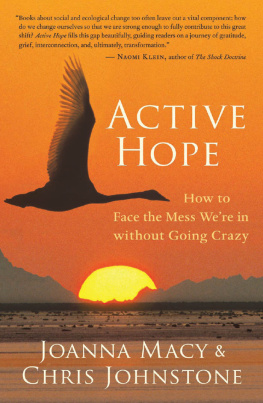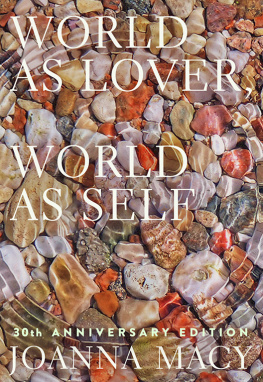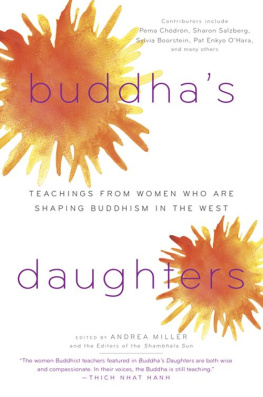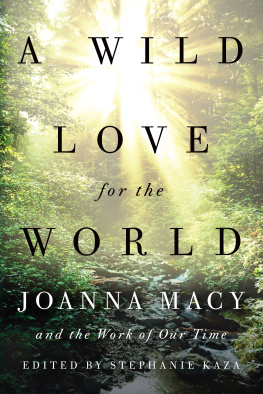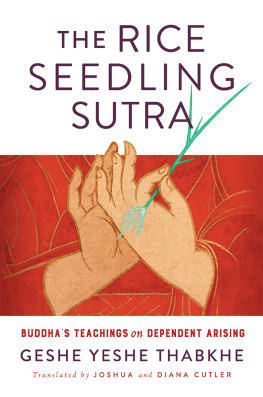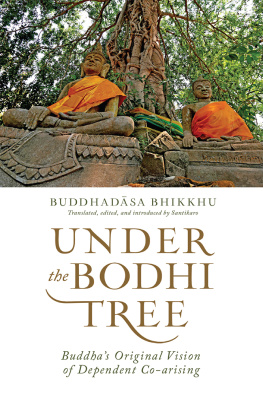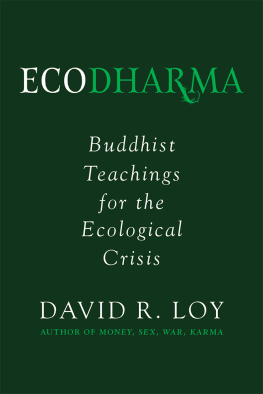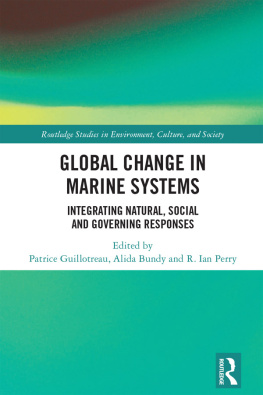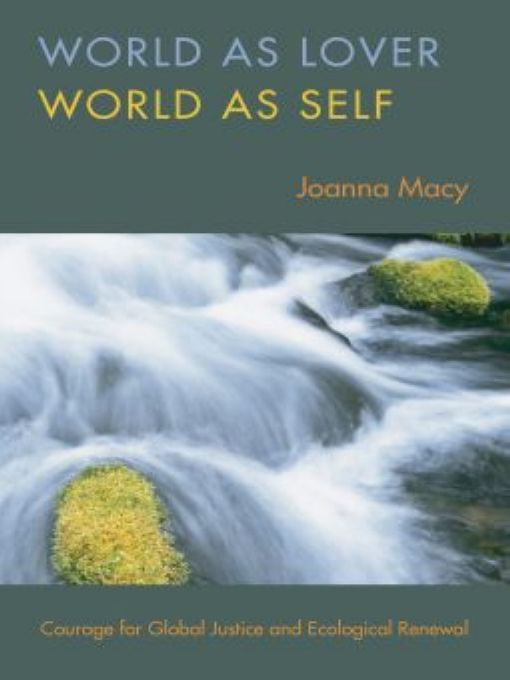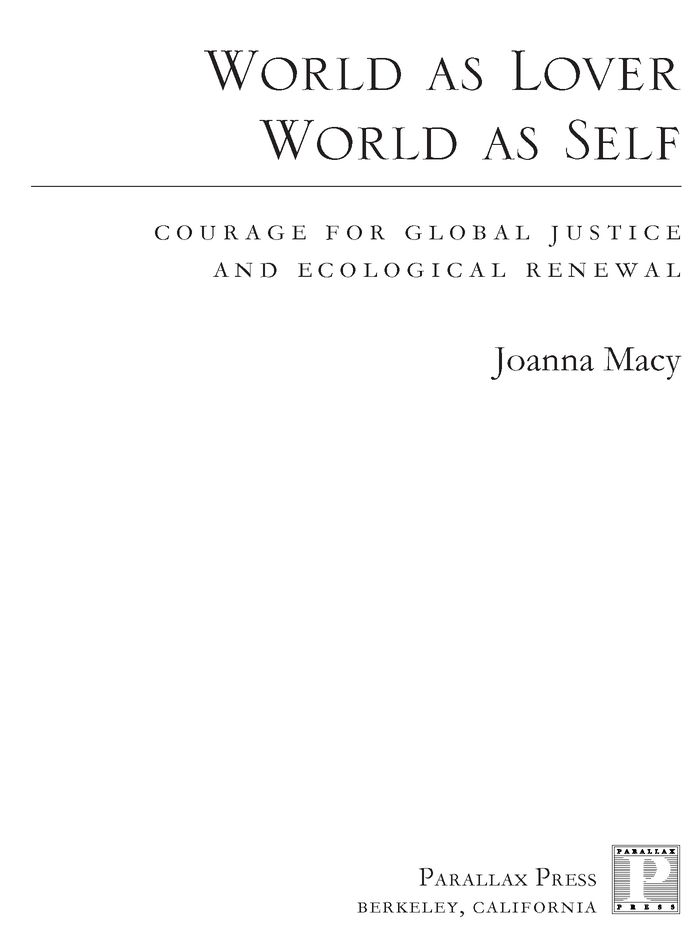Table of Contents
I should not like to have the bodhisattva think this kind of work hard to achieve and hard to plan out. If he did, there are beings beyond calculation, and he will not be able to benefit them. Let him on the contrary consider the work easy and pleasant, thinking they were all his mother and father and children, for this is the way to benefit all beings whose number is beyond calculation.
The Perfection of Wisdom in 8,000 Lines
FOREWORD
ON LABOR DAY WEEKEND 2006, a small band of concerned citizens took a long walk together to raise issues of climate change. They started in Robert Frosts birth place in Vermont and walked for five days to Burlington City Hall. Along the way they talked about our world and the world they want for their children. Each day more people joined the group until a thousand people were gathered at Battery Park. One by one, the political candidates of both parties for all the major offices came up to the stage and signed our climate pledge.
All of us in that crowd knew the world was in unprecedented danger from global overheating. Yet here we were, turning our despair into hope, our paralysis into action. As we engaged the impossible koan of climate change, we were planting seeds of faith and courage for the long haul. We were responding to the call to act on behalf of the larger whole, the miracle that is this earth our home. We were taking up the activists journey, each step moved by urgency but also fierce love.
In this new revision of Joanna Macys long beloved volume, World as Lover, World as Self, we have some companion wisdom for the long journey. Macys teachings over the past 30 years have been foundational for many activists and citizens anxious about the deteriorating state of the planet. Year after year, the concerns have mountedfrom pesticides to groundwater pollution, from factory farms to rainforest destruction. At times and in places, it has seemed the earth could not withstand the degree of assault inflicted upon it by its human inhabitants. Joanna Macy has offered visionary yet pragmatic leadership in facing the emotional pain of this assault. Her workshops around the world have galvanized thousands of people to take action. Using the powerful frameworks of systems analysis and ecopsychology, Macy provides tools that are effective in even the most daunting situations.
But more than tools, these chapters are filled with gifts of the heart and mind. Macy presents a way to be with seemingly impossible challenges, drawing on ancient teachings of the Buddha as well as modern views of eco-social systems. Here we find the core work of her doctoral research, more relevant than ever to environmental work today. She urges us to come home again to the world as both self and lover, to feel the way we are actually all connectednot in some fuzzy mystical trance state but in the very real material exchanges of air, water, flesh, and heat. Macy invites us to experience the ecological self, the way each of us is an expression of much larger self-organizing patterns.
As the decades have advanced, and environmental concerns seem only to multiply, many people shrug their shoulders and give up, convinced they cannot stop the bulldozer of progress. Joanna Macy takes the long view, investing in what she calls The Third Turning. Gazing into the future she sees the shift to Life-Sustaining Society already taking place, being called forth by ordinary citizens. For her the Great Work of this time is a fabulous adventure, risky on every front, but completely worth the effort. In these pages you can almost hear her spunky laughter ring out. How could we not join her on this great journey toward sanity and health?
It can be all too tempting to fall into the trap of feeling sorry for ourselves. How did we ever get into this overwhelmingly complex fix? Macy wastes no time in blame or anger, but takes the path of gratitude and grace. For her it is a grand privilege to be alive at this time, working together for this beautiful earth that has given us life. I see her now with that bright look in her eyes, gazing into the distance, hearing the prophecy of the Shambhala warrior. For Macy this is no dream, it is a potent human reality, limited only by our own small imaginations. This vision of a sustainable future will require, as she says, a burning patience and a willingness to be completely present to the larger whole.
It is a personal honor to introduce this new edition of Joannas work. For me, like many others, Joanna has been an inspiration, a guide, and a friend along the way. Her wisdom and rich imagination have brought life-giving energy to environmentally concerned citizens around the world. We are fortunate indeed to have such an articulate and impassioned teacher in these demanding times. It is my abiding hope that we can continue to keep each other company as each of us takes up the next piece of the work that reconnects.
Stephanie Kaza
INTRODUCTION
THE ADVENTURES flowing into this book differ greatly in circumstance. Some happened while exploring ancient texts, others while preparing testimony on nuclear waste disposal. Some arose while translating Rainer Maria Rilkes poetry or riding to the ruins of a Tibetan monastery. Yet they all reflect the same concern.
Carl Jung said that at the core of each lifes journey is one question we are born to pursue. The one question threading through my life here on this beautiful Earth is about how to be fully present to my worldpresent enough to rejoice and be usefulwhile we as a species are progressively destroying it. This book is my attempt to answer this preoccupation, as well as insight into the relief and guidance I have found in the teachings of the Buddha.
Since each chapter is shaped as a response to the same question, the chapters dont need to be read in sequence. Yet I like the order in which they appear. It mirrors my growing fascination with the play of time, and the fruitful presence in our lives of ancestors and future generations.
Part One casts an appreciative eye on the past. In what ways can our forebears help us to see our current world without fear and self-loathing? The title chapter delineates the four age-old ways we humans have seen our world: as a battlefield, as a trap, as a lover, and even as our larger self. The last two are rooted in appreciation of our profound interconnectedness with all that is. The following chapters turn to the Buddhas central teaching, the interdependence of all things, and what that can mean for us now. They draw substantially on my book Mutual Causality in Buddhism and General Systems Theory. I close this section with the love of my lifeat least the numinous, nonphysical part of itwhich is the Mother of All Buddhas. This feminine archetype of wisdom is for me an intellectual delight, emotional ground, and inner authority.
Part Two details the ways our ancestors wisdom is embodied in our lives today. Here I draw from my trainings for activists in the Work That Reconnects, an evolving body of group practices based on systems theory, deep ecology, and Buddhist teachings, and that is described in my book Coming Back to Life. This section begins with gratitude, whose constant and true power can carry us in this dark time. It strengthens us to go into the grief we carry on behalf of the world and its beings, ourselves included. There, we discover our mutual belonging. Ancestral voices are heard again in the Shambhala Warrior prophecy, coming through with special relevance to this moment on Earth. Before closing this section, I share specific spiritual practices that can help us take heart.


